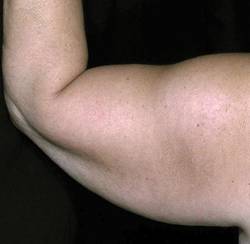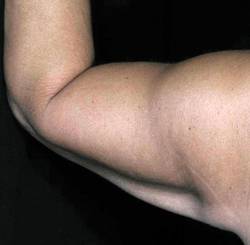PHOENIX - Treatment with a radiofrequency-assisted liposuction device resulted in improved reduction of upper arm circumference up to 12 weeks post treatment, results from a small single-center study showed.
A patient was treated with 20 W to 30 W of power, with a total energy of 31.5 kj per arm. |
"Traditional liposuction of the upper arms has been a challenge for patients, in particular for those with great volumes or a great amount of laxity," Dr. Lori Brightman said at the annual meeting of the American Society for Laser Medicine and Surgery. "This is a concern … for patients who want reduction of their upper arms or abdomen, because we're concerned about the loose skin that can result after removing the volume."
Dr. Brightman, of the Laser and Skin Surgery Center of New York, and her associates enrolled seven female patients with Fitzpatrick skin types II-IV to undergo treatment with BodyTite, a novel, bipolar, radiofrequency-assisted liposuction device with coagulation and simultaneous aspiration.
Manufactured by Invasix, the investigational device delivers radiofrequency energy from an internal electrode to an external electrode, which results in coagulation of adipose, vascular, and fibrous tissue, as well as heating of the soft-tissue matrix.
BodyTite features online monitoring of skin temperature, as well as monitoring of power and tissue impedance. It is powered by a 50- and 75-watt bipolar radiofrequency output system.
At baseline, the arm circumference was 39 cm. It reduced to 34 cm at week 12. Images courtesy Dr. Lori Brightman, Laser and Skin Surgery Center of New York |
The patients were 21-58 years old. They received one treatment on each upper arm and were assessed at 1, 3, 6, and 12 weeks. Assessments included the patient's body weight, standardized circumference tape measurements, two- and three-dimensional photography, caliper measurements, and biomechanical tissue characterization (BTC), which is an assessment of skin elasticity.
After standard tumescent anesthesia, the investigators treated the deeper planes of the upper arm skin, followed by the superficial planes; they treated to the loss of resistance at each level. The target epidermal temperature ranged from 38° C to 40° C, the radiofrequency energy ranged from 20 W to 35 W, and the total energy per zone ranged from 20.7 kJ to 30.4 kJ.
Dr. Brightman reported that the mean circumferential reduction among six of the seven patients who achieved a 6-week follow-up was 2.7 cm. Of the five patients who achieved a 12-week follow-up, the mean circumferential reduction was 4.3 cm.
The reduction in skinfold thickness (as measured by calipers) increased over time - from 7.5 mm between baseline and 3 weeks to 13.5 mm between baseline and 12 weeks. Mean skin laxity as measured by BTC went from 68% at 3 weeks to 58% at 12 weeks. Reduction in upper arm circumference was also evident on two- and three-dimensional photographs, Dr. Brightman said.
"You can improve and reduce the size of these larger arms with greater laxity with this bipolar radiofrequency device," she concluded.
Dr. Brightman disclosed that she is a clinical investigator for a number of device companies, including Invasix. She also holds stock options in the company.



